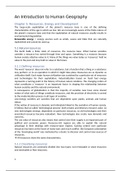An Introduction to Human Geography
Chapter 5: Resources, Energy and Development
The large-scale exploitation of the planet’s resource base is one of the defining
characteristics of the age in which we live. We are increasingly aware of the finite nature of
the planet’s resource base and that the exploitation of natural resources usually results in
environmental degradation.
Renewable energy = energy sources such as winds, waves and tides that are naturally
replenished and cannot be used up.
5.1 Natural resources
The Earth holds a finite stock of resources, the resource base. What human societies
consider a resource has varied through time and space. Something is a resource because
human society attaches value to it. Many of the things we value today as ‘resources’ held no
value in the past and may hold no value in the future.
5.1.1 Defining resources
The word ‘resource’ does not refer to a substance, but a function that a thing or a substance
may perform, or to an operation in which it might take place. Resources are as dynamic as
civilization itself. Each major human civilization was sustained by a particular set of resources
and technologies for their exploitation. Industrialization based on fossil fuel energy
represents a turning point in the history of human-nature relations. The changing notion of
what constitutes a ‘resource’ is an important factor in shaping the relationship between
human societies and the natural environment.
A consequence of globalization is that the majority of societies now have some shared
notion of what sorts of things constitute resources, and the provision of electricity is central
to the modernization process in all types of societies.
Low-energy societies are societies that are dependent upon plants, animals and human
labour.
If the notion of resource is dynamic and intimately linked to the evolution of human society,
it follows that so-called ‘technological process’ both creates and destroys resource value. As
new technologies emerge, dependent on particular resources, so old technologies and their
associated resources become redundant. New technologies also create new demands and
concerns.
The use value of resources also means that control over their supply is an important part of
political and economic power. Resource-rich regions are able to exploit this natural
advantage in their dealings with resource-poor regions. Gaining control over particular
resources has been at the heart of many wars and much conflict: the European colonization
of the ‘developing world’ was motivated by a desire to discover and control new sources of
resources.
All resources share the same characteristics.
5.1.2 Classifying resources
Natural resources are commonly divided into two types: non-renewable or stock resources
and renewable or flow resources.
1
,Renewable (flow) resources = resources that are naturally renewed within a sufficiently
short time-span to be of use to human society. This continuity of such resources is
increasingly dependent upon effective management. There are different kinds of flow
resources: ones in the critical zone and ones in the non-critical zone. Flow resources whose
continued availability of dependent upon management by society belong in the critical zone.
Critical zone resources become stock once regenerative capacity is exceeded. Resource
management aims to ensure that exploitation of a particular renewable resource does not
damage its capacity to replace itself.
Rees (1991): All resources are renewable on some time scale, what matters most for the
sustainability of future supplies is the relative rates of replenishment and use. It seems
better to think in terms of a ‘resource continuum’ than the conventional two-part typology.
Non-renewable (stock) resources = resources, mainly mineral, that have taken millions of
years to form. Their availability is therefore finite as there is no possibility of their stock
being replenished on a time-scale of relevance to human society.
Within the category stock resources, it is useful to distinguish between those that are
consumed by use, such as fuel minerals, those that are theoretically recoverable and those
that are recyclable, like aluminium. Stock resources tend to be highly localized: they are
found in relative abundance only in specific places. Some stock resources are more abundant
than others and their relative scarcity affects their value.
Non-renewable/stock resources Renewable/flow resources
Consumed Theoretically Recyclable Critical zone Non-critical
by use recoverable zone
Oil, gas, coal All elemental Metallic Fish, forests, Solar energy,
minerals minerals animals, soil, etc tides, wind, etc.
5.1.3 Resource availability
At any moment in time, there is a finite stock of natural resources on the planet, the
resource base. Each stock resource has its own resource base, the total quantity of a
substance or property on the planet. However, that total resource base is not the amount
available for human exploitation. The term proven reserve is applied to those deposits that
have already been discovered and are known to be economically extractable under current
demand, price and technological
conditions.
The model of resource availability has
the following components:
- Used
- Resource use – proven reserves:
These reserves are economically
recoverable. The extent of a proven
reserve is dynamic and dependent
upon a host of interlinked factors,
including the availability of the
technology and skills to exploit the
resource, the level of demand, the
2
, cost of production and processing, the price it can command in the market place, the
availability and price of substitutes, and the environmental and social costs of developing
the resource. These variables vary across time and space.
- Conditional reserves:
This category is sub-economic and refers to deposits that have already been discovered
but are not economic to work at prevailing price levels using currently available
extraction and production technologies. Conditional reserves can become proven
reserves if conditions change.
- Hypothetical resources:
Aren’t discovered yet. They are resources society may expect to find in the future in
areas that have only been partially surveyed and developed.
- Speculative resources
Aren’t discovered yet. They might be found in unexplored areas that are thought to have
favourable geological conditions
The strength of this classification is that is stresses the highly dynamic nature of the concept
of resource reserve. Its weakness is that it lends itself to the idea that we will never run out
of resources: there will always be more to discover, and new technology will continue to
make new resources available for exploitation. The planet now faces the additional problems
that the consumption of resources produces wastes that threaten the stability of the global
ecosystem. There is a need to rethink the whole notion of resource scarcity to take into
account the ecological cost of our current fossil fuels society.
Given the highly dynamic nature of resources it is very difficult to estimate the level of
resource availability. It is even more difficult to speculate about future levels of production
and consumption and the possibility of resource scarcity.
The prospect of increasing demand as a result of economic development in the ‘global
south’, combined with the challenges of climate change, has led to the idea of a ‘New Energy
Paradigm’ that combines traditional concern about security of energy supply at reasonable
prices with the need to devise energy policies that reduce carbon emissions.
The dimensions of resource scarcity
Type of Concern
scarcity
Physical - Exhaustion of minerals and energy
scarcity - Human populations exceed the food production capacity of the land
- Depletion of renewable resources such as fish, soils or timber
- Growing demand for water for human use threatens aquatic
ecosystems and the ability of river systems to replenish themselves.
Geopolitical - Use of minerals exports as a political weapon
scarcity - Shift of the location of low-cost minerals sources to ‘hostile’ or
unstable blocs of nations
Economic - Demand at current price levels exceeds the quantity supplied,
scarcity resulting in shortages
- Needs exceed to ability of individuals or countries to pay for resource
supplies (resource poverty)
- Rich economies can always outbid the poor for essential resources,
creating unequal patterns of resource use
3
, - Economic exhaustion or falling demand for specific minerals or
renewable resources causes economic and social disruption in
producer regions or in nations dependent on them
Renewable & - Distribution of essential biogeographical cycles threatening
environmenta sustainability of life on earth
l scarcity - Pollution loads exceeding the ‘absorptive’ capacity, causing economic
health and amenity problems
- Loss of biodiversity and landscape values, with wide, but poorly
understood, long-term consequences.
5.2 Fuelling the planet
For most of human history, societies have utilized renewables sources of energy; flow
resources such as wood that can be depleted, sustained or increased by human activity; and
continuous resources, such as water, that are available irrespective of human activity. The
Industrial Revolution changed the way in which certain parts of the world powered their
economies, leaving the remainder dependent upon renewable resources.
5.2.1 The dominance of fossil fuels
Since the invention of the steam engine, much of human society has become very much
dependent upon the exploitation of non-renewable resources. Fossil fuels likes coal, oil and
gas contribute to the majority of the primary commercial energy consumed on the planet.
These resources were formed from the decomposition of organic materials millions of years
ago and have been transformed by heat and pressure into coal, oil and natural gas. The
advantage of fossil fuels as a source of energy is that they are readily accessible, a highly
concentrated source of energy, easy to convert using proven technologies, and cost-efficient
in production and use. Unfortunately, the combustion of fossil fuels is also the single largest
source of greenhouse gasses (GHG).
Oil is the most versatile fossil fuel while coal, even though it is relatively bulky, is still used in
many industrial processes, as a source of heat, and is the most important fuel for electricity
generation. The great advantage of oil is its transportability over long distances in large
volumes. It has spawned a huge petrochemical industry producing a vast range of products
that have substituted products based on renewable resources. Oil has created many
resources for which commercially viable substitutes have yet to be developed. Advanced
industrial societies are totally dependent upon the continued supply of oil at a reasonable
price, which explains the importance that governments attach to energy security.
In recent years, natural gas has become an increasingly important source of energy and a
feedstock of petrochemicals. In many advanced industrialized economies, it has replaced
coal as the favoured resource for electricity generation and domestic heating. However, the
transport flexibility of natural gas is inferior to oil.
Liquefied natural gas (LNG) is an option but the process requires substantial investment in
plant and consumes large quantities of energy. Nevertheless, LNG production is becoming an
increasingly important fuel, particularly in the Asia-Pacific region, while the EU sees LNG
supplies as a means of compensating for declines in domestic production and diversifying its
sources of supply away from Russia.
4






